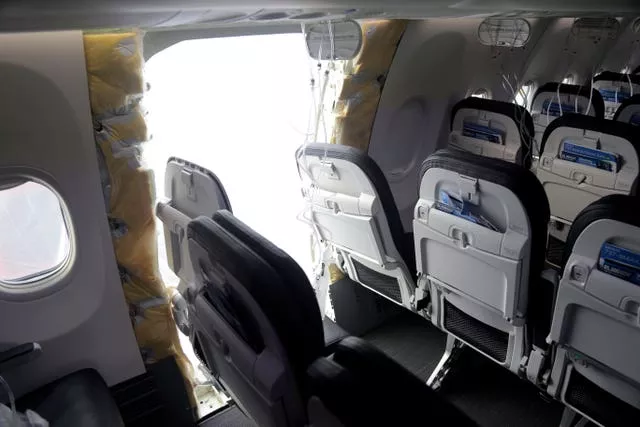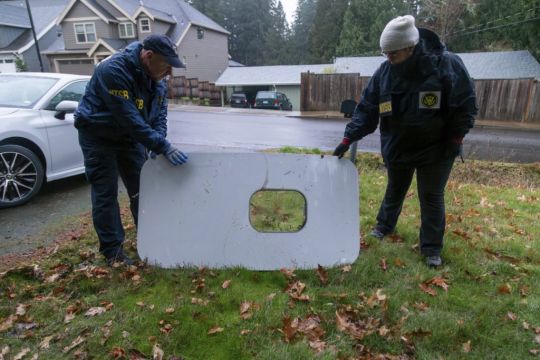United Airlines on Monday said it found loose bolts and other “installation issues” on a part of some Boeing 737 Max 9 jets that were inspected after a mid-flight blowout on a similar Alaska Airlines jet on on Friday.
The inspections are focused on plugs used to seal an area set aside for extra emergency doors that are not required on United and Alaska Max 9s.
“Since we began preliminary inspections on Saturday, we have found instances that appear to relate to installation issues in the door plug, for example, bolts that needed additional tightening,” Chicago-based United said.
The Federal Aviation Administration grounded all Max 9s operated by Alaska and United and some flown by foreign airlines, after a terrifying flight on Friday.
The Boeing jetliner that suffered an inflight blowout over Oregon was not being used for flights to Hawaii, after a warning light that could have indicated a pressurisation problem lit up on three different flights.
Alaska Airlines decided to restrict the aircraft from long flights over water so the plane “could return very quickly to an airport” if the warning light reappeared, Jennifer Homendy, chairwoman of the National Transportation Safety Board, said on Sunday.
Ms Homendy said the pressurisation light might be unrelated to Friday’s incident in which a plug covering an unused exit door blew off the Boeing 737 Max 9 as it cruised about three miles over Oregon.
On Monday, the FAA approved guidelines for inspecting the door plugs on other Max 9 jets and repairing them, if necessary. That move could speed the return to service of the 171 planes that the FAA grounded.
Alaska has 64 other Max 9s, and United Airlines owns 79 of them. No other US airlines operate that model of the Boeing 737.
Shares in The Boeing Co. fell 8% and those of Spirit AeroSystems, which builds the fuselage for Boeing’s 737 Max, tumbled 11% on Monday, the first day of trading since the incident occurred.

Shares in Alaska Airlines were nearly unchanged after slumping earlier in the session.
The auto-pressurisation system warning on the ill-fated Alaska Airlines jet lit up during three previous flights.
Ms Homendy said she did not have details about a December 7 incident, but that it came on again during a flight on January 3 and after the plane landed on January 4 – the day before the blowout.
“We plan to look at that more, and we’ve requested documentation on all defects since delivery of the aircraft on October 31,” she said.
The NTSB said the lost door plug was found on Sunday near Portland, Oregon, in the back garden of a home.
Investigators will examine the plug, which is 26in by 48in and weighs 63lbs, for signs of how it broke free.
Investigators will not have the benefit of hearing what was going on in the cockpit during the flight. The cockpit voice recorder, one of two so-called black boxes, recorded over the flight’s sounds after two hours, Ms Homendy said.
NTSB has recovered the door plug from Alaska Airlines Flight 1282 Boeing 737-9 MAX. NTSB investigators are currently examining the door plug and will send it to the NTSB Materials Laboratory in Washington, DC for further examination. pic.twitter.com/fqeemNeBPW
— NTSB Newsroom (@NTSB_Newsroom) January 8, 2024
At a news conference on Sunday Ms Homendy provided new details about the chaotic scene that unfolded on the plane.
The explosive rush of air damaged several rows of seats and pulled insulation from the walls. The cockpit door flew open and banged into a toilet door.
The force ripped the headset off the co-pilot and the captain lost part of her headset. A quick reference checklist kept within easy reach of the pilots flew out of the open cockpit, Ms Homendy said.
Two mobile phones that appeared to have belonged to passengers on Friday’s terrifying flight were found on the ground. One was discovered in a garden, the other on the side of a road.
The plane made it back to Portland, however, and none of the 171 passengers and six crew members was seriously injured.
Hours after the incident, the FAA ordered the grounding of 171 of the 218 Max 9s in operation, including all those used by Alaska Airlines and United Airlines, until they can be inspected. That led to flight cancellations at both carriers.
Early Monday, Alaska Airlines was forced to cancel 20% of all flights, 141 in all. United cancelled 221 flights, or 8% of its total flights scheduled for Monday.
We are deeply sorry for the disruption the 737-9 MAX grounding has caused our guests. We expect the disruption to last through at least mid-week. For the very latest information visit: https://t.co/wVG6kzt4ru
— Alaska Airlines (@AlaskaAir) January 7, 2024
Boeing chief executive Dave Calhoun called a companywide webcast to talk about the incident with employees and senior leadership for Tuesday.
“When serious accidents like this occur, it is critical for us to work transparently with our customers and regulators to understand and address the causes of the event, and to ensure they don’t happen again,” Mr Calhoun wrote in a message to employees Sunday.
“This is and must be the focus of our team right now.”
Alaska Airlines flight 1282 took off from Portland on Friday for a two-hour trip to Ontario, California.
About six minutes later, the chunk of fuselage blew out as the plane was climbing at about 16,000 feet.
One of the pilots declared an emergency and asked for clearance to descend to 10,000 feet, where the air would be rich enough for passengers to breathe without oxygen masks.
Videos posted online by passengers showed a gaping hole where the panelled-over door had been. They applauded when the plane landed safely about 13 minutes after the blowout.
Firefighters came down the aisle, asking passengers to remain in their seats as they treated the injured.
It was extremely lucky that the airplane had not yet reached cruising altitude, when passengers and flight attendants might be walking around the cabin, Ms Homendy said.







